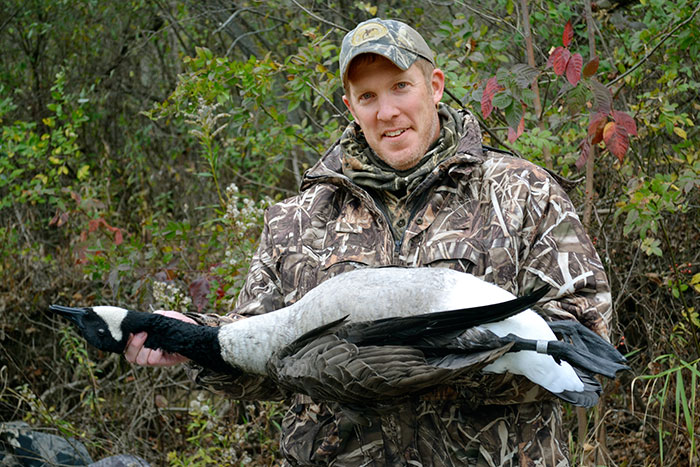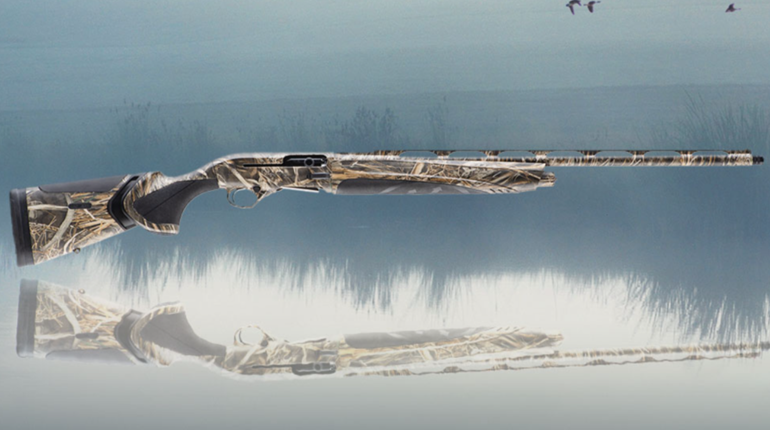The mallard decoys bobbed lazily amidst the narrow, ice-crusted slough, their only companions being the full-body black ducks set optimistically ashore. Cool January air contrasted with the warmth of my jacket, causing a sedative effect, and it was in that floaty window between sleep and consciousness that I swore I heard a goose.
Kerr-honk!
"Was that geese?" asked my friend Tyler, confirming the reality of it all.
We hadn't bothered with goose decoys, as we'd never seen Canadas take even vague interest in the thin, drake-producing strip. But here they came—massive Canada geese, no doubt of the giant subspecies—over the trees and, curiously, down into our duck spread like huge, white-cheeked mallards.
We were loaded for ducks, but the shot was called at a distance in which pellet size matters little. All six geese were promptly felled.
We felt like kings to have partaken in this fluke experience, but it seems these days that resident populations of Canada geese—largely consisting of the giant subspecies—can materialize practically anywhere. The latest estimate reveals that they dominate or rival migratory populations in all flyways, with 1.08 million giant Canadas in the Atlantic Flyway, 1.45 million in the Mississippi, and more than 1 million in the Central and Pacific combined. They're prevalent in habitats ranging from marshes and agricultural fields to golf courses, town-square fountains and mall parking lots. I once tweeted a photo of them munching the grass landscaping of National Rifle Association headquarters. They are, in short, so populous as to be considered a pest by many.
And yet how fortunate we are to suffer their inconveniences: Just over 50 years ago, many taxonomists declared that the giant Canada goose was in fact extinct.
"In my humble opinion, the conservation success of giant Canada geese is right up there with the comeback of the wild turkey, wood duck and bald eagle," said John Coluccy, director of conservation planning for Ducks Unlimited.
Here then is the unlikely story of how biologists and hunter-conservationists brought the giant Canada goose from presumed extinction to considerable overpopulation in just four decades.
 Fallen Giants
Fallen Giants
When Europeans arrived on American soil, populations of giant Canada geese stretched from prairie Canada to the Great Lakes and south to the Mississippi Valley and Tennessee. According to Ducks Unlimited, Lewis and Clark noted an abundance of large-bodied, nesting geese along the Missouri River in 1804—these were very likely giant Canadas. However, in the century to follow, giant Canadas were rapidly extirpated across much of their range.
The devastation of giant goose populations owes to a combination of settlers' ignorance to the destruction and the birds' natural, non-migratory instincts. There is a common misconception that resident geese are simply Canadas that somehow lost their migratory instincts. Not so: They never had them to begin with. Giant Canadas do not fly far north to nest and only push south to the extent they are forced by heavy snow. Thus when Europeans arrived, the birds endured a veritable year-round slaughter. They were shot for food and down feathers; their wetlands were drained; even their eggs were plucked from nests. These losses were further exacerbated by the dawn of the market era. In 1905 a Canada goose fetched 50 cents on the East Coast market—nearly $13 in today's dollars.
And so market gunners shot every one they could.
The result? By the 1950s, at least nine expert taxonomists had declared the giant Canada—the world's largest goose—officially extinct.
A Monumental Discovery
Given the giant subspecies' presumed extirpation and also that of the Atlantic Canada goose—a long-extinct, pre-colonial resident of the Atlantic Flyway—hunters and biologists longed to restore local goose populations. The United States Fish and Wildlife Service released 332 Canada geese in Michigan's Seney National Wildlife Refuge as early as 1936."Then beginning in the 1950s, agencies in Manitoba, Wisconsin, Minnesota, Missouri and Ohio began releasing captive geese," said Coluccy. "South Dakota, Iowa, Illinois, Indiana, Louisiana and Tennessee joined the effort in the 1960s."
These reintroduction attempts got the conservation ball rolling in the right direction, but enjoyed only limited successes. That is, until a monumental discovery: In 1962, Dr. Harold C. Hanson of the Illinois Natural History Survey identified a small remnant flock of giant Canada geese in Rochester, Minn. Conservationists were jubilant.
"As documented in Hanson's book, The Giant Canada Goose, the rediscovery added much fuel to restoration efforts across the historic range," said Coluccy.
Live Decoys: Curse and Cure
In addition to Hanson's rediscovery of wild giant Canadas, he noted numerous domesticated geese in the United States and Canada that were undoubtedly of giant subspecies origins. Such geese were used for food and, most especially, as live decoys prior to prohibition of the practice. In an ironic twist, these privately held giant geese—which contributed so much to their wild cousins' near-demise—proved the primary source of birds for relocation.
"Most of the reintroductions—and by far the most successful ones—consisted of these wild-strain, captive flocks," Coluccy explained. "Prior to their discovery, early efforts to reestablish Canada geese in the 1950s involved use of wild, trapped birds from migrant flocks of interior Canada geese—a smaller subspecies. These efforts failed, because the birds didn't produce goslings in captivity."
Giant Canadas, however, are fighters. They proved resilient when reintroduced to habitats and, as importantly, they bred in captivity, allowing repeated release of captive birds until wild breeding populations were solidified.
The Goose Boom
Once biologists established that the use of giant Canadas for reintroduction was not only ideal, but necessary, the boom was on; according to Coluccy, by the 1970s—roughly 10 years after giant geese were classified as extinct—complaints arose regarding nuisance geese on private lands and in urban settings.
"Early control efforts typically involved relocation, where birds were captured at problem locations and transported to state game areas," Coluccy said. "Populations grew quickly. By the 1980s, special early- and late-hunting seasons were introduced in many states to stem population growth."
In part these dramatic population growths owed to the sheer volume of geese released: Central Flyway states and provinces alone accounted for the release of 121,743 geese from 1967 to 1999; and at least 125,390 birds were released in the Mississippi Flyway, though many efforts did not record exact goose quantities.
Yet one cannot simply toss a few hundred thousand geese into the wild and expect the ensuing population explosion. In part it may be credited to the tenacious parental instincts of giant Canada geese. Namely both goose and gander are ferociously protective of their nests and goslings, as anyone who's been nipped in the behind by a ticked off mama goose can attest. And, at an average weight of 12.5 pounds with some males exceeding 20 pounds, I (just slightly) pity the red fox that happens upon a giant Canada's nest. Giants additionally reach sexual maturity at age 3—among the earliest of all geese—resulting in on one of the highest reproduction and nesting success rates of all Canada goose subspecies.
However, something unforeseen also entered the equation: Like whitetail deer, the giant Canada goose absolutely thrives in suburban environments. New-growth grasses and sedges are among the giants' favorite foods, which is why they've so readily taken to golf courses, homeowners' yards, drainage ponds—truly anywhere regularly visited by a lawnmower.
"By the mid-1990s, restoration efforts were being curtailed," said Coluccy. "Most efforts proved so successful that they were discontinued by 1990."
Nationwide Giant Canadas
Suffice it to say that these days no states or provinces are willing to accept relocated giant Canada geese. In a span of less than 20 years, management goals have shifted from population expansion to control. The Mississippi Flyway Council believes it has about 450,000 more giant Canadas than the flyway can healthily support; and the Atlantic Flyway Council would like to reduce Eastern giants (technically mixed-race geese due to vast, early reintroductions of other subspecies) by 430,000 birds.
Giant Canadas have not only reclaimed their historic range, they are presently found in every continental U.S. state. Their population now hovers around 4 million, driving total North American Canada goose populations to perhaps the highest in history and accounting for the majority of Atlantic Flyway (81 percent) and Mississippi Flyway (82 percent) goose populations.
Resident geese are hunted as early as August and as late as March, with typical limits of 15 birds daily. Such liberal regulations, coupled with ongoing population growth, has led to soaring hunter-harvests: from 500,000 birds killed annually in the mid-1960s to about 2.5 million today.
These days giant, resident Canadas are largely taken for granted. But let us not forget the efforts of biologists and concerned hunters whose hardships allow us the privilege of enjoying these big, lovely birds. Thanks to committed conservation efforts, it took less than one human generation for giant Canada geese to rebound from the brink of extinction to providing arguably the greatest hunting opportunity ever afforded to waterfowlers.






































